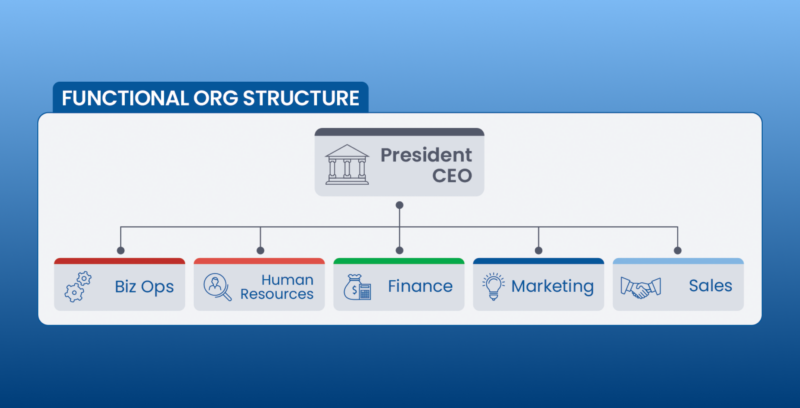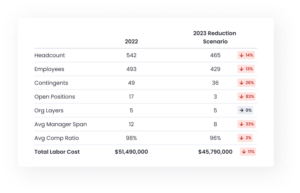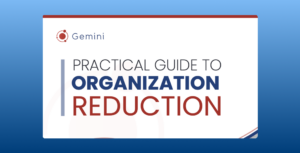Organizational Structures for Business
An organization’s ability to achieve success is often a direct result of the company’s ability to identify and implement a strong and well-defined organizational structure.
An established organizational structure is the operational blueprint of a company that can indicate or dictate how companies are run and managed. When properly implemented and executed, it can encourage efficiency, improve communication, guide company culture, reinforce company values, and, ultimately, impact its overall success.
As company leaders and executives choose and implement the “right” organizational structure for their business – one where departments, teams, individual employees, and management are aligned, understand their tasks, and are working together – the potential to achieve company goals is vastly increased.
A well-designed organizational structure will clearly lay out the different levels of management, the business units on each level, and the responsibilities and key productivity indicators of each entity. Organizational structures should also indicate major departments, teams, and charters, and describe the specific roles of each within the overall operation as well as show the proper channels of communication.
(For examples to review, Gemini has a number of free org charts for download here.)
With a solid organizational structure in place, a company becomes like a fine watch – each gear and cog in its proper place, connected to the right people and teams, and completing its specific tasks on time and within the framework of the overall objective.
When there is organizational misalignment, however, the results can range from the relatively minor – miscommunications and misunderstandings between employees or departments and overlapping or redundant/repeated tasks – to the more serious, impactful, and expensive – missed deadlines, incompatible work efforts, and employees and managers struggling with disjointed workflows which can result in teams failing to execute their goals, disappoint customers or clients, and falter in achieving company objectives.
If a greater level of efficiency and productivity are desired goals for your company, we suggest reviewing how your company is organized and how well that structure is defined, understood, and implemented.
There are three main types of organizational structures: Functional, Business Unit, and Matrix. Each type has different variations with different strengths and weaknesses – all explored in this article.
In choosing the best organizational structure, it is important to consider the size and nature of the company, as well as its goals and objectives. The optimal structure should take into consideration the company’s current strengths and challenges, support the company’s operations, and enable it to achieve its goals in the most efficient and effective way possible
Functional Organization Structure
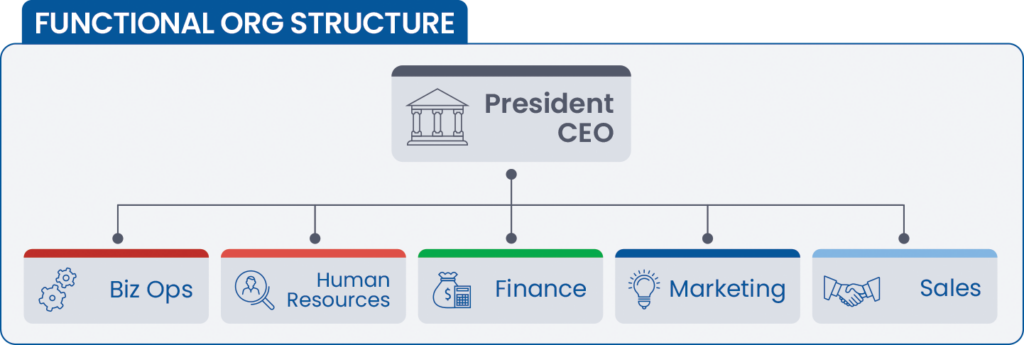
A Functional Organizational Structure is the most common type of business structure, and divides the company into departments based on their area of expertise (such as marketing, finance, and human resources, etc.). This structure features clear lines of authority, well-defined lines of communication, and the specialization of tasks, with each department led by a manager who is responsible for overseeing the work of the department or team.
In a Functional Organizational Structure, employees are grouped together based on their skills and expertise and are assigned to a specific department. Each department is then responsible for a specific area of the company’s operations and works closely with other departments to ensure that the organization’s overall goals and objectives are met.
On the whole, the Functional Organizational Structure is a good fit for companies seeking to simplify operations or those with a more defined product or service offering, as it allows for clear lines of authority and specialization of tasks.
Strengths of a Functional Organization Structure:
- Specialization of Tasks: By allowing for the specialization of tasks and assignments, employees can be easily grouped together based on their skills and expertise within specific departments creating a streamlined, focused operation excelling in the handling and resolution of related issues.
- Clear Lines of Authority and Communication: The Functional Organizational Structure provides clear lines of authority and communication with each department led by a single functional manager providing a consistent voice as they lead, guide, and direct their employees.
- Efficiency: The Functional Organizational Structure enables the organization to operate efficiently as each department is able to focus on its specific area of expertise. As this occurs, productivity can increase as each department better understands their responsibilities and fulfills its role.
Challenges of a Functional Organization Structure:
- Productivity Silos: The Functional Organizational Structure can lead to a lack of communication resulting in silos of information and communication as each department operates independently and may not interact with or effectively support other departments.
- Lack of Coordination: The Functional Organizational Structure can result in a lack of coordination between departments as each department, lead by a separate manager and given differing directives, may create its own set of competing priorities and goals.
- Incompatibility with Complex Operations: The Functional Organizational Structure may not be suitable for companies with complex or dynamic operations as the rigidity of the structure may inhibit the interaction, flexibility, and interdepartmental coordination necessary to effectively manage an operationally dynamic company.
Divisional/Business Unit Organization Structure:
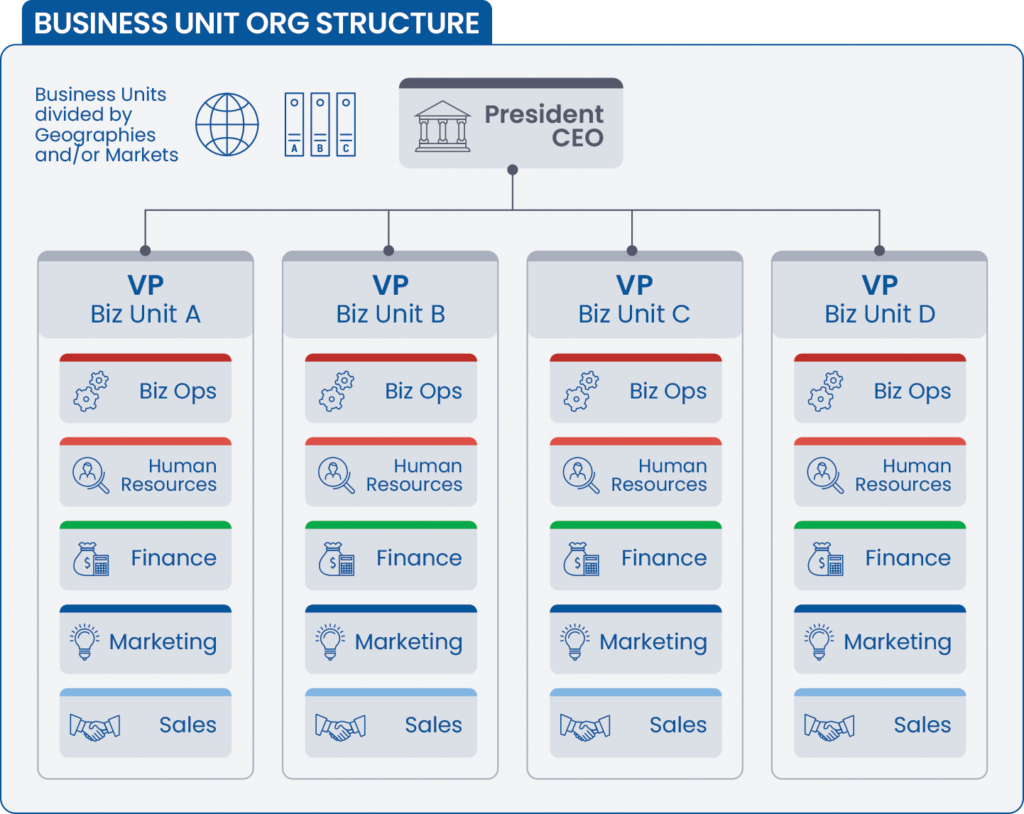
A Business Unit Organizational Structure divides the company into smaller units based on markets, geography or other classification, each with its own teams, leadership, and departments. This structure allows for greater autonomy and increased flexibility as each business unit is able to operate independently and make decisions based on its own goals, objectives and the unique challenges they face.
In this structure, each business unit is responsible for a specific product or service line and is led by a divisional manager or business unit head. These individuals are responsible for overseeing the budgeting, staffing, and strategic planning needs of their specific business unit as dictated by their unique situations and circumstances.
Overall, the Business Unit Structure is a good fit for companies with complex operations or a diverse product or service offering as it allows for greater flexibility in addressing specific operational needs and challenges.
Strengths of a Divisional/Business Unit Organization Structure:
- Autonomy and Flexibility: The Business Unit Structure features greater autonomy and flexibility as each division or business unit is able to operate independently and make decisions based on its own goals and objectives.
- Specialization of Tasks: The Business Unit Structure allows for greater specialization of tasks as each division or business unit is able to focus on its specific strengths or area of expertise as it relates to its defined market.
- Clear Lines of Authority: The Business Unit Structure provides clear channels of authority and communication, with each division or business unit led by a single divisional or business unit manager, improving lines of communication and increasing the clarity and understanding of required tasks and goals.
Challenges of a Divisional/Business Unit Organization Structure:
- Duplication of Efforts/Potential Conflict: The Business Unit Structure can lead to a duplication of efforts and/or lack of coordination between business units resulting in potential conflict as each unit operates independently with different priorities and goals.
- Complexity: The Business Unit Structure can be complex with multiple similar departments to organize and oversee and becomes even more so with each additional market or division opened by the company. As each business unit operates within its own “eco-system” of teams and leaders with separate agendas and protocols, the multiple groups of operation competing for time, energy and resources can become increasingly difficult to manage.
- Communication Challenges or Silos: The Business Unit Structure can create communication challenges as information may not flow easily or translate between business units resulting in information silos that can inhibit helpful dialogues and prevent the sharing of successful strategies or protocols.
Matrix Organizational Structure

A Matrix Organizational Structure is a hybrid of the functional and divisional structures with the organization divided into functional departments – such as marketing, finance, and human resources – and project teams, which are formed based on specific projects or goals.
In a Matrix Organizational Structure, each project team is led by a project manager who is responsible for coordinating the team’s efforts and ensuring that assigned projects are completed on time and within budget. Functional managers are then responsible for overseeing the work of their departments and ensuring that employees have the resources and support they need to perform their tasks effectively.
Employees report to both their functional department and their project team. This structure allows for greater collaboration and coordination between departments as employees are encouraged to work with different teams and departments on their projects and tasks, benefitting from different perspectives, approaches, and methodologies.
Overall, the Matrix Organizational Structure, when properly organized and implemented, promotes collaboration and interaction between multiple teams, departments, and employees which can result in a more robust and successful end result.
Strengths of a Matrix type of Organizational Structure:
- Improved Coordination and Collaboration: The Matrix Organizational Structure allows employees to work closely with different departments, teams, and individuals increasing collaboration, gaining valuable outside perspectives, and leading to better overall results.
- Flexibility: The Matrix Organizational Structure allows for increased flexibility in terms of creating project teams, collecting available insights and perspectives, and enables the organization to pull from multiple resources and experiences. This broader and more dynamic approach can lead to uniquely effective solutions to specific and complex issues.
- Increased Efficiency: When properly implemented, the Matrix Organizational Structure can provide for greater collaboration and the implementation of additional resources to resolve issues more quickly, enabling the organization to operate more efficiently.
Challenges of a Matrix type of Organizational Structure:
- Complexity: The Matrix Organizational Structure can become complex, with employees reporting to multiple managers and departments and working on multiple projects with a wider assortment of colleagues, leading to possible confusion and potential conflicts. (This approach may not be suitable for small organizations, as it requires a larger workforce and more resources to implement effectively.)
- Potential for Conflict: The Matrix Organizational Structure can lead to confusion for employees as functional managers and project managers may have different priorities and goals, contrasting styles of leadership, or incompatible approaches to problem or conflict resolution.
- Communication Challenges: The Matrix Organizational Structure can create potential communication challenges as employees may not be clear on who they report to or who is ultimately responsible for the final call or direction on specific tasks.
As is probably clear by now, when it comes to organizational structures, there is no one-size-fits-all solution.
The best way to determine which structure is right for your business is to evaluate and set your business goals and objectives and then design different org structure options for your company to see the strengths and challenges your organization might face in each. Once these are established, you can choose which type of organizational structure best matches your organization and helps you achieve those goals.
The Gemini software platform can help in this effort by allowing you to easily visualize any number of organizational structure scenarios, see how they will impact your current organizations and teams, and, ultimately, help you choose and implement the best option to achieve success.


